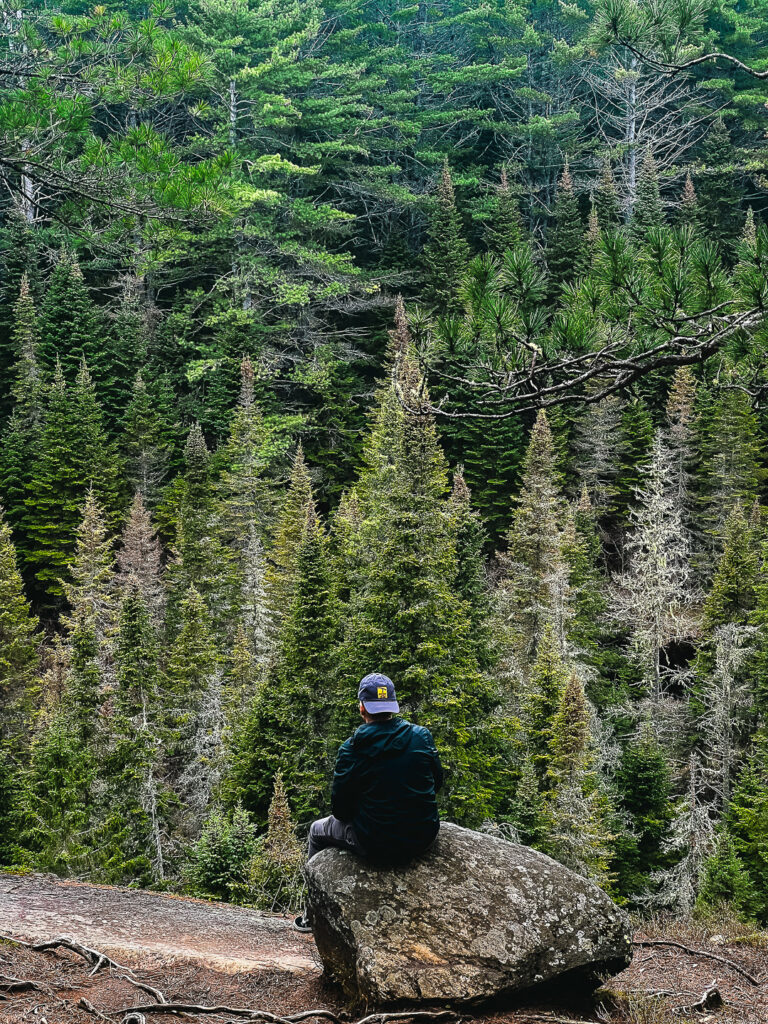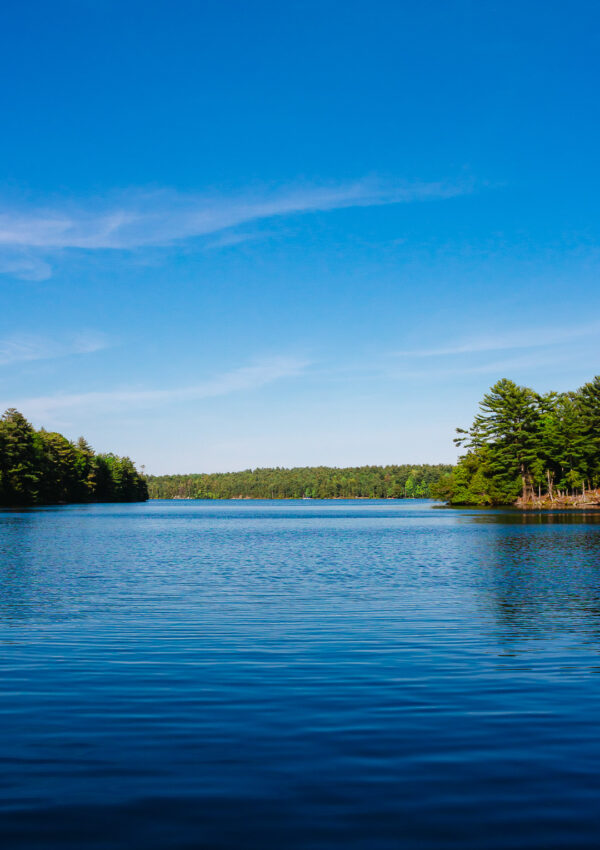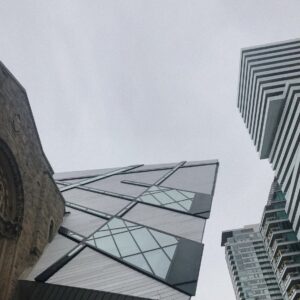Disclaimer: This blogpost contains affiliate links. If you purchase or book through an affiliate link, I receive a small commission.
Algonquin Provincial Park is the oldest and most famous of all the provincial parks in Canada. It’s also the largest park in the Ontario Parks system. All of this can make Algonquin seem intimidating for beginner campers. But it’s actually one of the best spots for first-timers to learn about the outdoors!
Algonquin Provincial Park is located in northern Ontario, conveniently located about a 3 hours drive from both Toronto and Ottawa. While Algonquin is known for its backcountry and canoe-in camping, it’s also renowned for its car camping. There are plenty of campgrounds to choose from. Most first-timers decide to camp along Highway 60. This itinerary will give you an ideal weekend for making the most of your time in Algonquin Provincial Park.
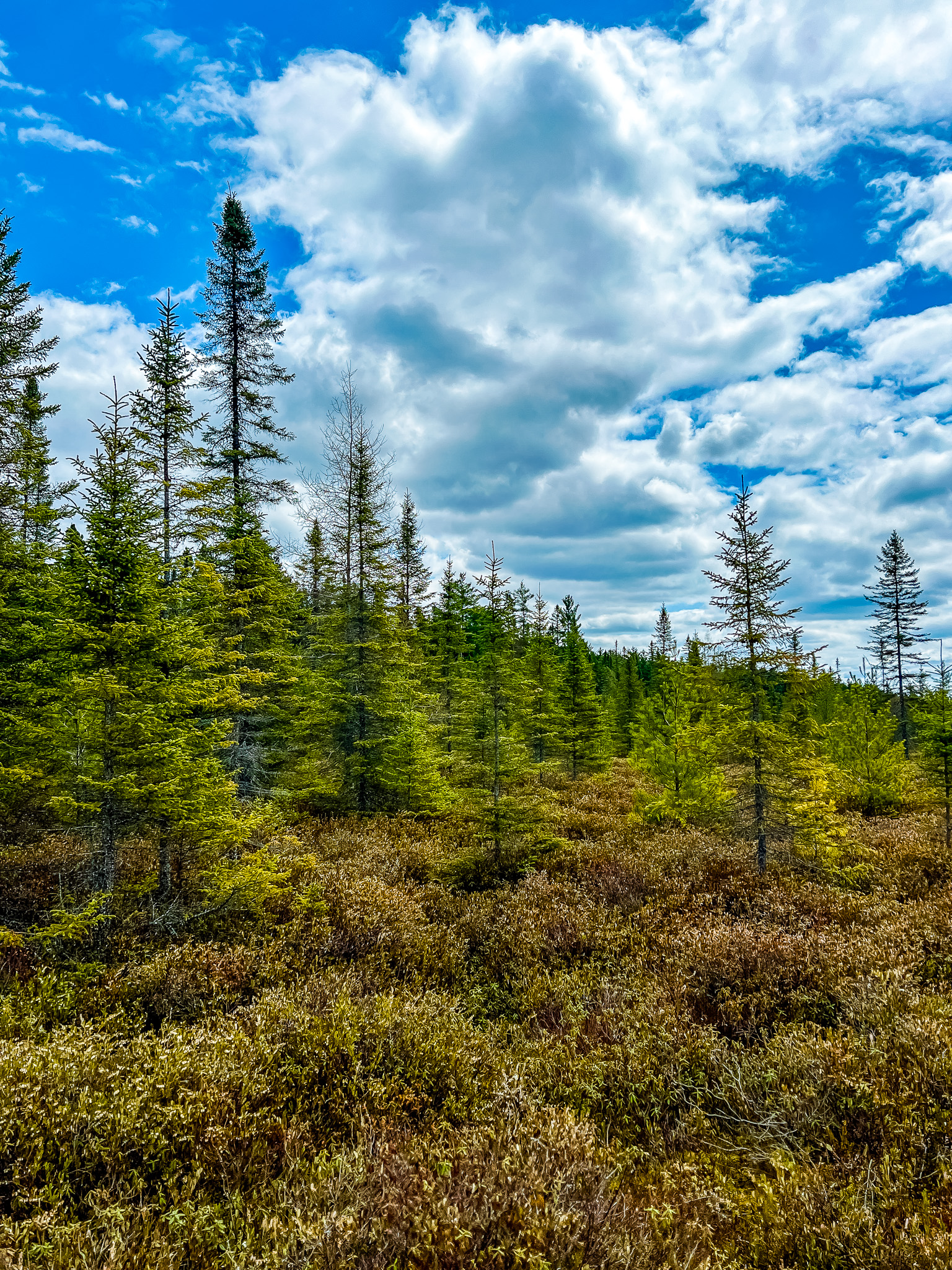
Where to Stay in Algonquin Provincial Park
Stay at Mew Lake Campground Along Highway 60
There are six campgrounds for car camping along Algonquin’s Highway 60 corridor. Lake of Two Rivers is one of the most popular, while just next door is Mew Lake. I believe Mew Lake is the ideal campground to stay in along Highway 60 because it’s much smaller and quieter than its counterparts, and it’s conveniently located at the midpoint between Algonquin’s East and West Gates, leaving all of Highway 60 for your exploration!
Mew Lake Campground is located at km 30.6 along Highway 60 and features both electric and non-electric campsites. There are also several campsites on the lakeshore, as well as a few yurts and cabins for those who aren’t ready to brave tent camping, or for those who want a little more luxury in the outdoors.
This weekend, we camped at Site 114, with a single tent. Our site was right on Mew Lake, though it was a pretty marshy spot. While you can launch a canoe from some of the campsites, I would not at this one. You could also see cars driving past on Highway 60, and you could see other campers across the water since Mew Lake is shaped like a crescent moon. I would be more mindful of that when choosing sites in Mew Lake in the future.
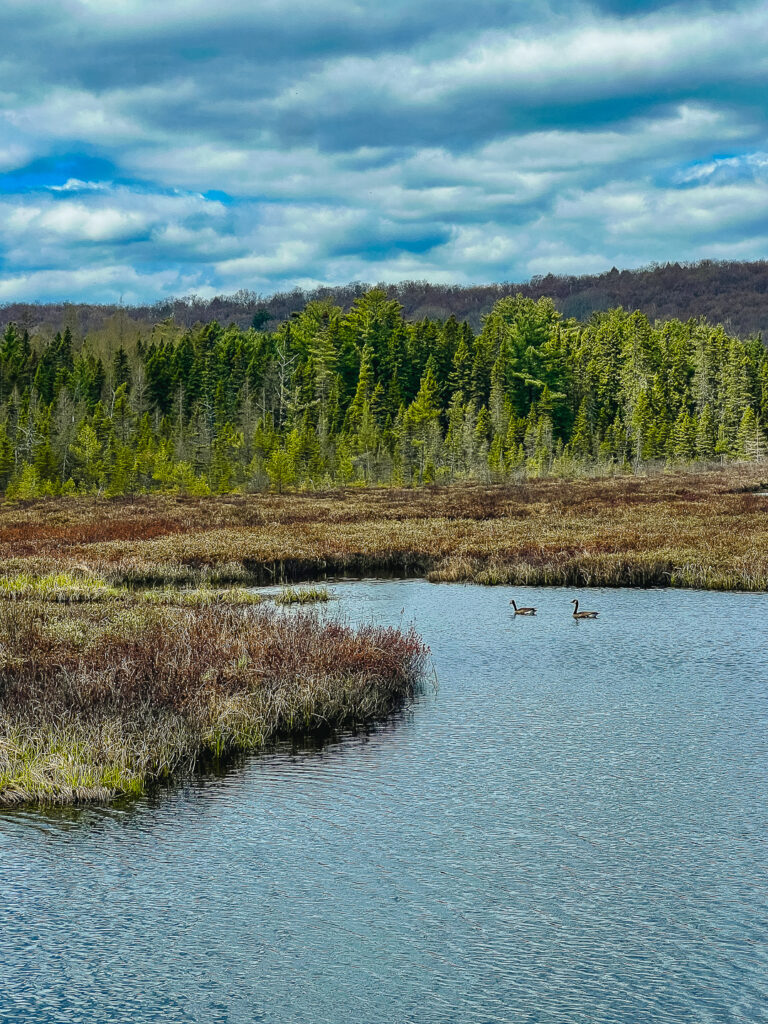
Camping Rules at Mew Lake and Algonquin Provincial Park
Note: for those bringing their pets, dogs are allowed at Mew Lake Campground with some restrictions. There is one yurt and one cabin that are both pet-friendly, the rest are not. Sites 95-131 do not permit dogs (or radios).
Also, remember to check for any fire restrictions and boil water advisories before collecting water from the campground taps. Firewood, kindling, and fire starters are available at the campground offices. Always purchase firewood locally, and never move firewood due to its risk of introducing invasive species. It is especially important for beginner campers and hikers to educate themselves on the 7 Leave No Trace Principles.
These days you don’t need to check in with the park rangers at the campground office, nor do you have to print your camping permit and display it on your vehicle dashboard. Instead park staff will check your vehicle’s license plate number, so ensure you enter it correctly. You’ll need another permit if you’re camping with more than one vehicle.
Mew Lake Campground is also open year-round, but for this guide, we visited in the Spring! Algonquin Provincial Park is an incredible Ontario Park to visit every season, and much of this guide can be applied to the remainder of the year.
What to do in Algonquin Provincial Park
Take A Hike
There are 18 day-use hikes along Algonquin’s Highway 60 corridor. Many of them are beginner-friendly, as they are short and considered easy to moderate in difficulty. We stayed for one night and managed to squeeze in 6 different hikes. You don’t have to do this many on a single trip, but doing a few different hikes is a great way to discover Algonquin’s biodiversity and variety of wildlife habitats.
In the summer months, paper trail guides with a map of the trail system and an interpretive guide are available at the trailheads in exchange for a small donation. At other times of the year, you can purchase these trail guides at the Algonquin Visitor Centre. There will also be a map and key information about the trails at the trailhead kiosks. Be mindful when hiking trails with cliff viewpoints. Remember if a trail parking lot is full, hike a different trail.
The following are some of the easier and shorter hikes along Highway 60:
Hardwood Lookout Trail – km 13.8
The Hardwood Lookout Trail is closer to the West Gate of Algonquin Provincial Park. It is located at km 13.8 along the Highway 60 Corridor. This trail is only 0.8km in length, but this loop is considered moderate since it has some elevation gain culminating in a view over Smoke Lake. Hardwood Lookout Trail should take you less than 1 hour to complete.
Along the trail, you’ll be immersed in a typical Algonquin hardwood forest. At the the Smoke Lake viewpoint you’ll also see a historical cairn dedicated to Douglas McDonald Hains, for his conservation efforts. Don’t miss the Red Spruce Side Trail on the opposite end of the Hardwood Lookout parking lot. This is a super short additional loop with some tree identification signs. You’ll start to identify the various trees that make Algonquin Provincial Park their home.
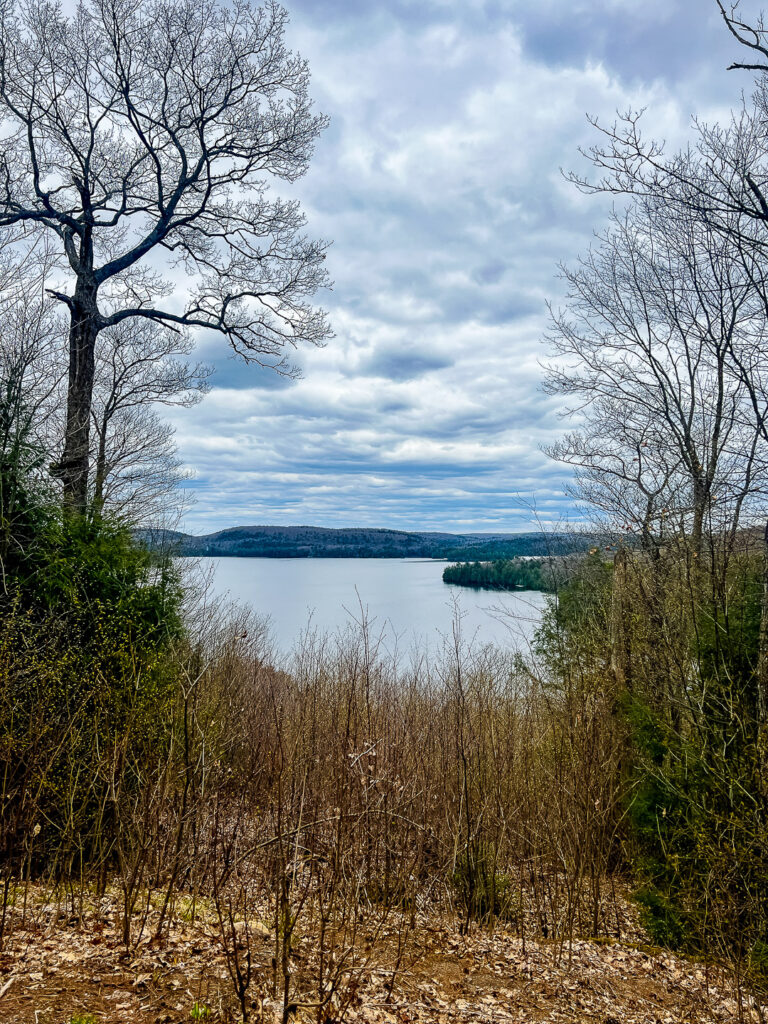
Two Rivers Trail – km 31
Two Rivers Trail is located almost directly across from Mew Lake Campground at km 31. Don’t let the trail name fool you! There are several wonderful viewpoints along this trail overlooking Algonquin’s vast white pine forests. This is also considered a moderate hike due to the hike up to a cliff, but it is a short 2.1km loop and should take around 1 hour to complete.
Two Rivers Trail is a slower ascent than the other Algonquin trails with cliff-top viewpoints, so this is the most beginner-friendly lookout hike. And it’s worth the reward since there are four different lookout points along the trail.
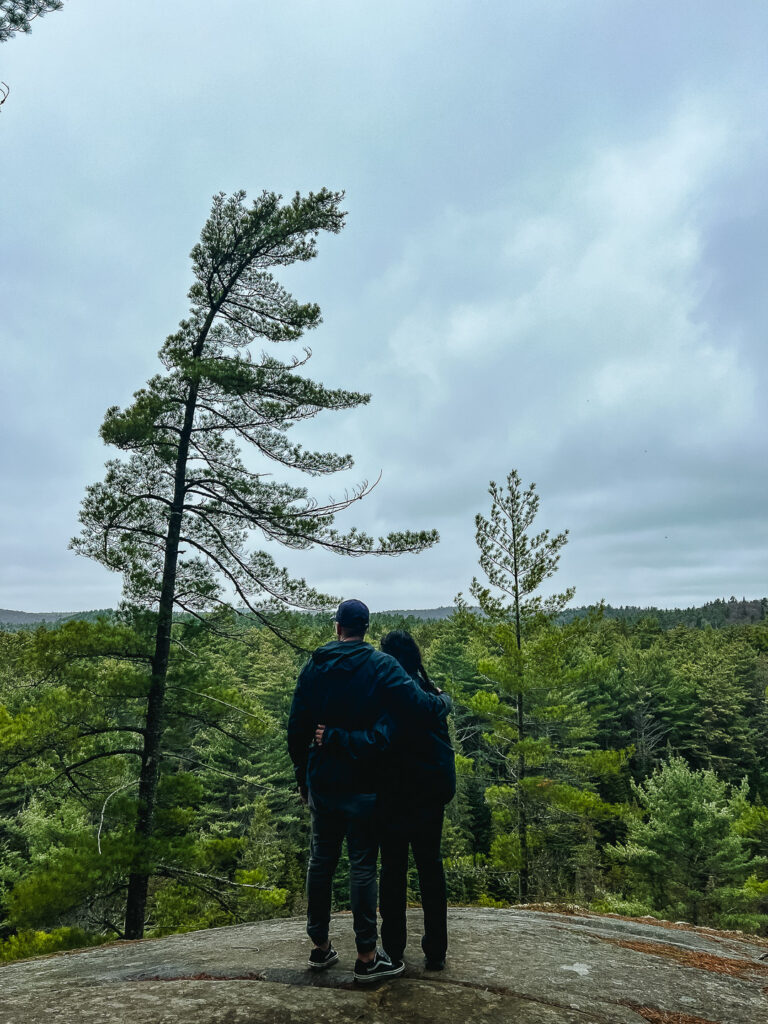
Lookout Trail – km 39.7
Lookout Trail is the steepest of these three viewpoint trails along Algonquin’s Highway 60 Corridor. It is located at km 39.7 and is a 1.9km loop, and once again is considered moderate due to the trek to the cliff top. This trail should take you less than 1 hour to complete.
This trail is especially great at sunset as you’ll see the sun going down over the horizon once you get to the trail’s main viewpoint.

Spruce Bog Boardwalk – km 42.5
The Spruce Bog Boardwalk is one of my favourite trails along Algonquin’s Highway 60 Corridor. It is located at km 42.5 and is a 1.5km loop that will take less than 1 hour to complete. This is an easy trail, is wheelchair accessible, and takes you through one of Algonquin’s most unique habitats, a bog!
Spruce Bog Boardwalk is located on the opposite side of Highway 60 from the Algonquin Visitor Centre, ideal for those only visiting Algonquin Provincial Park for the day. You’ll see a lot of wildlife along this trail, especially birds that make their home in the bog and the forest. The boardwalk brings you across the bog, and into the forest, where you’ll see another smaller spruce bog.
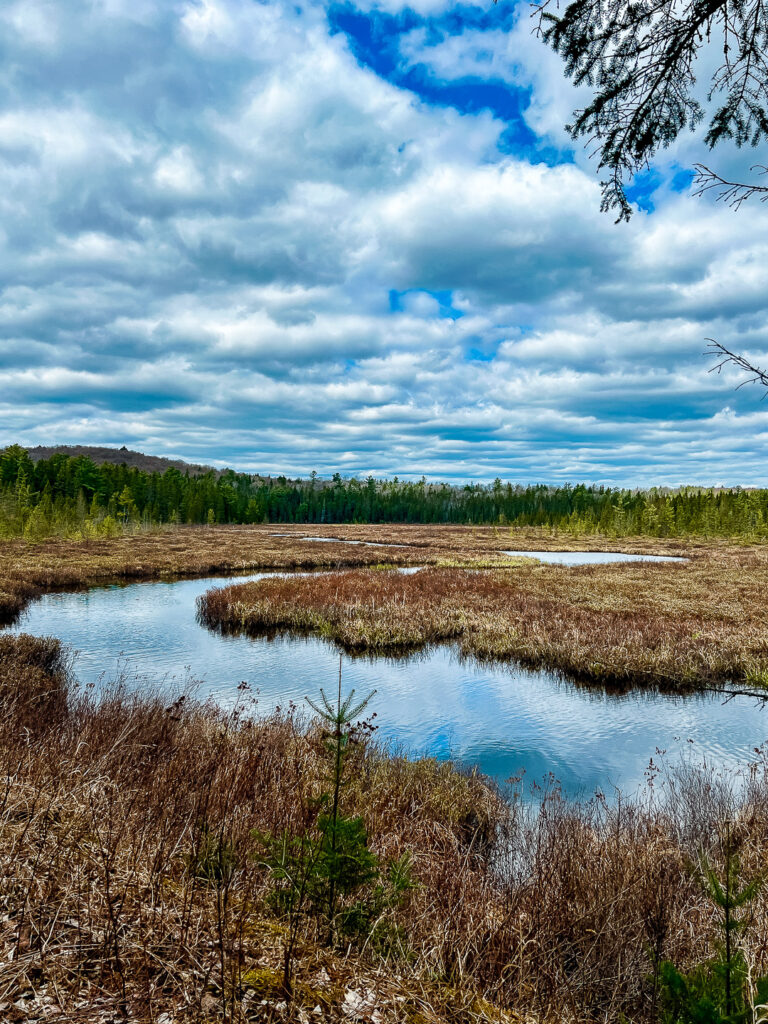
Beaver Pond Trail – 45.2km
Beaver Pond Trail is another of my favourites along Algonquin’s Highway 60 Corridor. While it’s another trail considered moderate, as it offers a little climb, I found this one easy and takes around 1 hour to complete. Beaver Pond Trail is located at km 45.2 and is a 2km loop through two beaver ponds.
Beaver ponds are one of the most unique habitats in Algonquin because they are created through the intervention of wildlife, the beaver of course! There are some boardwalks along this trail and you’ll see a few beaver lodges and a dam. Towards the trail’s end, you’ll be brought to the viewpoint overlooking the beaver ponds. I highly recommend bringing binoculars on this trail. While we didn’t see any beavers on our hike, we did see a diving loon in the distance!

Algonquin Logging Museum Trail – 54.5km
The Algonquin Logging Museum Trail is located just inside the East Gate at km 54.5, ideal for those entering Algonquin from Whitney. This is one of the easiest trails in the park. It is a 1.3km loop that takes around 1 hour to complete. From late June to mid-October, the Logging Museum and Bookshop are open to the public, but you can hike this trail year-round.
The Logging Museum Trail is a great one for kids. Since it explores Algonquin’s logging industry history, many pieces of historical machinery and shelters are along the trail. Don’t miss the recreation of a historical camboose logging camp, and make sure you step inside The Alligator, a steam-powered amphibious tugboat that would tow logs across lakes.

There are a few more easy hikes along the Algonquin Highway 60 Corridor, these were just the ones we had time to do this weekend.
Watch for Moose in Algonquin Provincial Park!
One of the number one reasons people visit Algonquin Provincial Park is to catch a glimpse of their wildlife, most famously the moose. Sometimes moose can be elusive. While you’ll have an easier time spotting them in the backcountry, they do turn up along Highway 60 occasionally. Spring is the best time to see moose along Highway 60. Since moose’s winter diets are salt-deficient, they’re attracted to the roadside during Spring to lick up the salt from winter road maintenance. Dusk and dawn are the best time of day to see moose.
Spotting moose along Highway 60 can cause “moose traffic jams”. You must view these animals safely and respectfully, and remain mindful of other drivers.
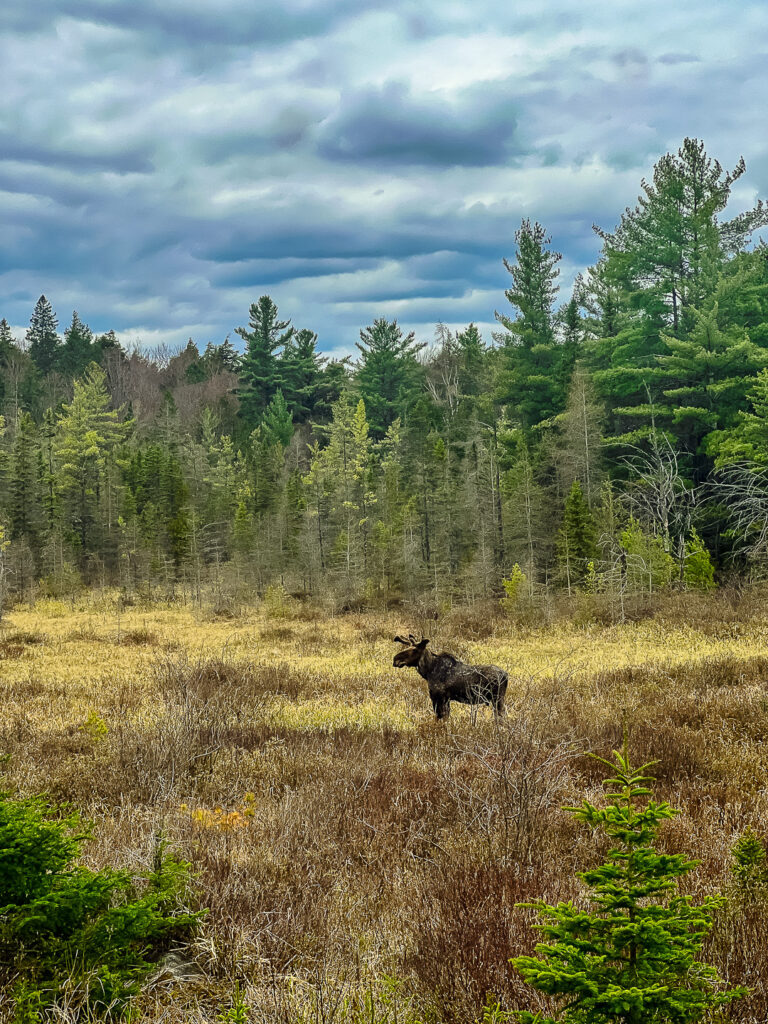
Safe Wildlife Viewing Guidelines
- Pull Over Safely
Section 170 of the Ontario Highway Traffic Act allows parking on a highway if your vehicle is visible for at least 125m in each direction and does not interfere with traffic. Park your vehicle off the road as much as possible, and never on a turn.
- Use Your Hazard Lights
When parking turn on your hazard lights. This warns other drivers that you’re stopped, but also to be mindful of wildlife in case the animal gets spooked and decides to run across the highway. Do everything you can to avoid causing a collision.
- Keep Your Distance From Wildlife
It is better to view moose and other animals from the safety of your car. If you choose to leave your vehicle, stay near it and keep at least 25m away and more if you see a mother moose and her calf. They are very protective animals! If you are watching a moose and it flattens its ears the length of its body (rather than ears pointing to the sky), the moose is warning you that it may charge.
Check out the Algonquin Visitor Centre
The Algonquin Visitor Centre is a great spot to visit to beat the heat or avoid the rain! This indoor building is located at km 43 and features exhibits about Algonquin’s wildlife, and human history from Indigenous peoples, the Logging era, to our present. You’ll see a lot of taxidermied animals, and artifacts from humans that used to live in Algonquin Provincial Park. Check out the short film in the Visitor Centre theatre about the park’s history. Get a few souvenirs from the bookshop and check out the small art gallery. Serve-yourself snacks are also available at the Sunday Creek Cafe. Finally, step out onto the observation deck and see a beautiful view of Sunday Creek. You can also view Sunday Creek from the Firetower Side Trail just outside the Visitor Centre entrance.
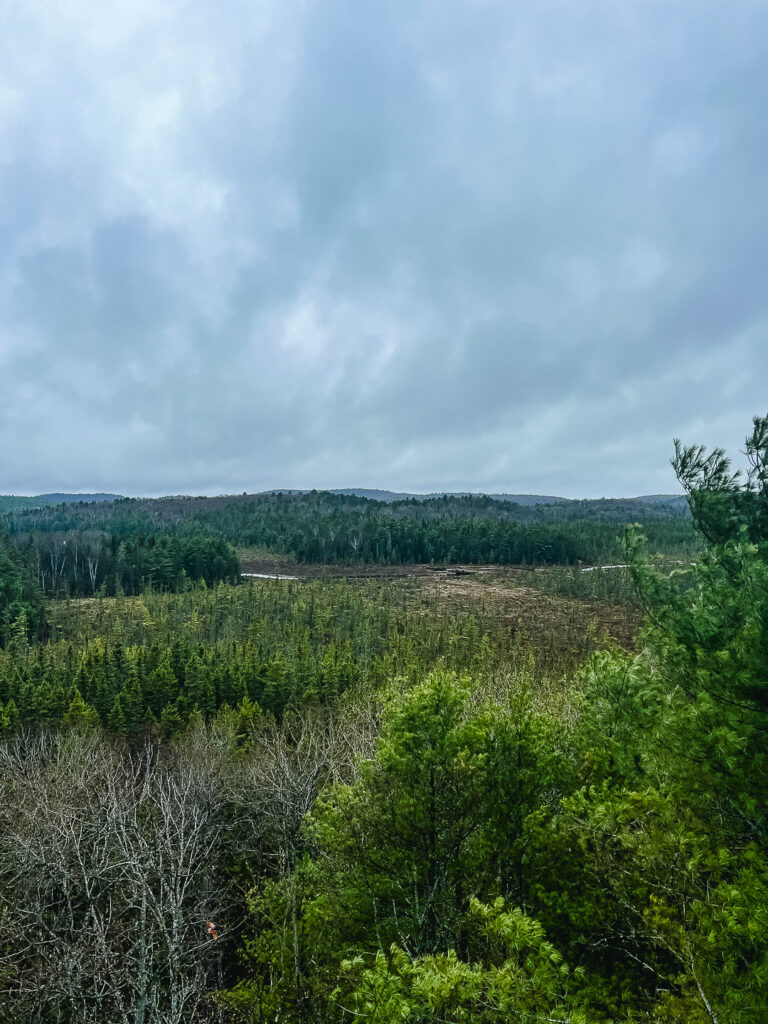
Explore Outside Algonquin Provincial Park
You could spend 100 years inside Algonquin Provincial Park and still not see all of it. But that doesn’t mean you shouldn’t visit the towns outside the park gates! We came into Algonquin from the East Gate through Whitney, Ontario. For dinner one evening we decided to drive into town and stumbled across Bongopix Tavern and I cannot recommend this place enough!

We watched a Leafs Game here and the staff were incredibly welcoming and kind. They learned our names, doted on us, and played live music between hockey periods. The vibes were immaculate! They played everything from Neil Young to The Band. I had a campfire latte, which was a fancy coffee with marshmallow and graham cracker crumble, and I had their falafel panini with coleslaw.
There are plenty more activities to do at Algonquin Provincial Park, but I hope this gives you a taste of what to expect from one of the most beautiful places in all of Canada. I cannot wait to visit Algonquin Provincial Park in the summer, autumn, and winter months.
Do you plan on visiting Algonquin Provincial Park this year? Book your next Ontario Parks camping trip!
